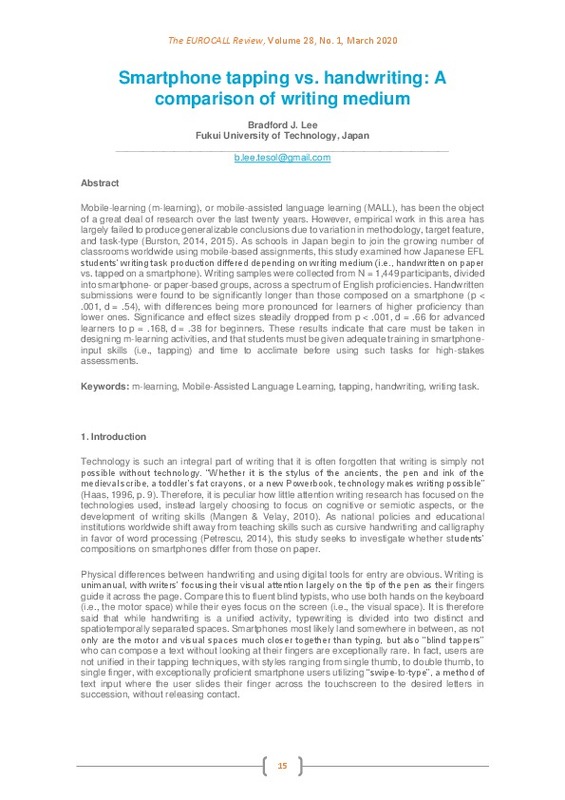Baron, D. (2009). A better pencil: Readers, writers, and the digital revolution. Oxford: Oxford University Press.
Beare, K. (2018, October 8). How many people learn English? https://www.thoughtco.com/howmany-people-learn-english-globally-1210367.
Burston, J. (2014). The reality of MALL: Still on the fringes. CALICO Journal, 31(1), 103125. https://doi.org/10.11139/cj.31.1.103-125
[+]
Baron, D. (2009). A better pencil: Readers, writers, and the digital revolution. Oxford: Oxford University Press.
Beare, K. (2018, October 8). How many people learn English? https://www.thoughtco.com/howmany-people-learn-english-globally-1210367.
Burston, J. (2014). The reality of MALL: Still on the fringes. CALICO Journal, 31(1), 103125. https://doi.org/10.11139/cj.31.1.103-125
Burston, J. (2015). Twenty years of MALL project implementation: A meta-analysis of learning outcomes. ReCALL, 27(1), 4-20. https://doi.org/10.1017/S0958344014000159
Collier, R., & Werier, C. (1995). When computer writers compose by hand. Computers and Composition, 12(1), 47-59.
https://doi.org/10.1016/8755-4615(95)90022-5
Connelly, V., Gee, D., & Walsh, E. (2007). A comparison of keyboarded and handwritten compositions and the relationship with transcription speed. British Journal of Educational Psychology, 77(2), 479-492. https://doi.org/10.1348/000709906X116768
Chen, Y., Carger, C. L., & Smith, T. J. (2017). Mobile-assisted narrative writing practice for young English language learners from a funds of knowledge approach. Language Learning & Technology, 21(1), 28-41. https://dx.doi.org/10125/44594.
Elgort, I. (2017). Blog posts and traditional assignments by first- and second-language writers. Language Learning & Technology, 21(2), 52-72. https://dx.doi.org/10125/44611.
Ellis, R. (1997). The interaction hypothesis: A critical evaluation. Paper presented at the Regional Language Center Seminar, Singapore, April 22-28, 1991.
Ellis, R. (2009). Corrective feedback and teacher development. L2 Journal, 1(1), 318. https://doi.org/10.5070/L2.V1I1.9054
Gass, S., & Selinker, L. (1994). Second language acquisition: An introductory course. Hilldale, N.J.: Lawrence Erlbaum Associates.
Gentile, C., Riazantseva, A., & Cline, F. (2001). A comparison of handwritten and word processed TOEFL essays: Final report. (TOEFL Research Council). Princeton, NJ: ETS.
Godwin-Jones, R. (2017). Smartphones and language learning. Language Learning & Technology, 21(2), 3-17. https://dx.doi.org/10125/44607.
Haas, C. (1996). Writing technology: Studies on the materiality of literacy. Mahwah, N.J.: L. Erlbaum Associates. https://doi.org/10.4324/9780203811238
James, K. H., & Engelhardt, L. (2012). The effects of handwriting experience on functional brain development in pre-literate children. Trends in Neuroscience and Education, 1(1), 3242. https://doi.org/10.1016/j.tine.2012.08.001
James, K. H., & Gauthier, I. (2006). Letter processing automatically recruits a sensory-motor brain network. Neuropsychologia, 44(14), 29372949. https://doi.org/10.1016/j.neuropsychologia.2006.06.026
Kiefer, M., Schuler, S., Mayer, C., Trumpp, N., Hille, K., & Sachse, S. (2015). Handwriting or typewriting? The influence of pen- or keyboard-based writing training on reading and writing performance in preschool children. Advances in Cognitive Psychology, 11(4), 136146. https://dx.doi.org/10.5709%2Facp-0178-7
Lantolf, J. (2000). Second language learning as a mediated process. Language Teaching, 33(2), 79-96. https://doi.org/10.1017/S0261444800015329
Lee, B. (2019a). Japanese tertiary students' access to smartphones and their feelings regarding their use in the EFL classroom. Memoirs of Fukui University of Technology, 49, 216-224.
Lee, B. (2019b). A case study of writing task performance: Smartphone input vs. handwriting. Memoirs of Fukui University of Technology, 49, 225-231.
Long, M. H. (1996). The role of the linguistic environment in second language acquisition. In W. C. Ritchie & T. K. Bhatia (Eds.), Handbook of second language acquisition (pp. 413-468). New York: Academic Press. https://doi.org/10.1016/B978-012589042-7/50015-3
Longcamp, M., Zerbato-Poudou, M-T., & Velay, J. (2005). The influence of writing practice on letter recognition in preschool children: A comparison between handwriting and typing. Acta Psychologica, 119(1), 67-79. https://doi.org/10.1016/j.actpsy.2004.10.019
Longcamp, M., Boucard, C., Gilhodes, J., & Velay, J. (2006). Remembering the orientation of newly learned characters depends on the associated writing knowledge: A comparison between handwriting and typing. Human Movement Science, 25(4-5), 646656. https://doi.org/10.1016/j.humov.2006.07.007
Mangen, A., & Velay, J. (2010). Digitizing literacy: Reflections on the haptics of writing. In M. H. Zadeh (Ed.), Advances in Haptics. IntechOpen, 385-401. https://doi.org/10.5772/8710
Matsuo, K., Kato, C., Okada, T., Moriya, T., Glover, G., & Nakai, T. (2003). Finger movements lighten neural loads in the recognition of ideographic characters. Cognitive Brain Research, 17, 263-272. https://doi.org/10.1016/S0926-6410(03)00114-9
Mogey, N., Paterson, J., Burk, J., & Purcell, M. (2010). Typing compared with handwriting for essay examinations at university: letting the students choose. ALT-J, 18(1), 2947. https://doi.org/10.1080/09687761003657580
Mueller, P. A., & Oppenheimer, D. M. (2014). The pen is mightier than the keyboard: Advantages of longhand over laptop note taking. Psychological Science, 25(6), 11591168. https://doi.org/10.1177/0956797614524581
Nyugaku, N., Koyama, M., Lee, B., & Thomson. S. (2017). On the application of communicative approach in English education at Fukui University of Technology. (Japanese language). Memoirs of Fukui University of Technology, 47, 373-381.
Petrescu, A. (2014). Typing or writing? A dilemma of the digital era. eLearning & Software for Education, 2, 393-397. https://doi.org/10.12753/2066-026x-14-115
Plato. (c. 370 B.C.) Phaedrus [EPub]. http://www.gutenberg.org/ebooks/1636.epub.images?session_id=723fa a18883337783d2449c2a9d8e262a8cad15b.
Plonsky, L., & Oswald, F. (2014). How big is "big"? Interpreting effect sizes in L2 research. Language Learning, 64(4), 878-912. https://doi.org/10.1111/lang.12079
Schmidt, R. (1990). The role of consciousness in second language learning. Applied Linguistics, 11(2), 129-158. https://doi.org/10.1093/applin/11.2.129
Tsai, C.-H., Kuo, C.-H., Horng, W.-B., & Chen, C.-W. (2012). Effects on learning logographic character formation in computer-assisted handwriting instruction. Language Learning & Technology, 16(1), 110-130. http://dx.doi.org/10125/44277.
Wolfe, E. W., Bolton, S., Feltovich, B., & Bangert, A. W. (1996). A study of word processing experience and its effects on student essay writing. Journal of Educational Computing Research, 14(3), 269-283. https://doi.org/10.2190/XTDU-J5L2-WTPP-91W2
Wolfe, E. W. & Manalo, J. R. (2004). Composition medium comparability in a direct writing assessment of non-native English speakers. Language Learning & Technology, 8(1), 53- 65. http://dx.doi.org/10125/25229.
[-]









